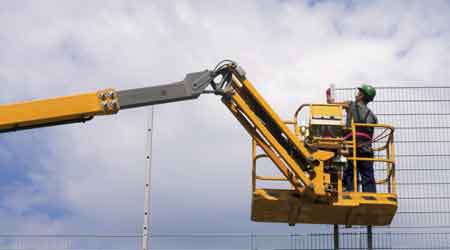Manufacturers of Aerial Work Platforms Emphasize Safety
Part three of a 3-part article on aerial work platform safety
The manufacturer’s role in safe use of lifts is threefold. They introduce design improvements that promote safety, they offer training and training materials and facilities, and they provide documentation of safe practices in operation and maintenance manuals.
Equipment design emphasizes the lift’s features that contribute to safe operation. For example, tipping has caused serious accidents. Now many lifts feature instruments that warn operators when the combination of load, reach, and leaning position due to slope of the surface on which the lift operates are at the equipment limit. A warning sounds in the cab, and the equipment is prevented from continuing in the unsafe manner.
Manufacturer-provided training courses can help operators become familiar with these features and the hazards they address. These courses are available in various formats — online, at the manufacturer’s location, or at the user’s site.
A train-the-trainer strategy is another option for managers. With this option, the operator or technician receives the training required to become a certified trainer and then serves as the go-to person for all training needs at the facility. A manufacturer also can provide operator and maintenance training course materials to be used by the owner’s certified trainer at the owner’s site.
One additional advantage of training at the manufacturer’s site is that the offering encompasses both classroom and hands-on training. Hands-on training is done at a site that is specific for the purpose. These courses include testing and certification documentation for recording the testing results. These documents, signed by the trainer and the student, provide a record of the training by specific aerial lift equipment make and model as required by OSHA. Departments also can provide re-training and pre-use training in this manner.
Manufacturers go to great lengths to emphasize the importance of reading the entire manufacturer’s operating and maintenance manuals material before operating the aerial work platform equipment. But besides operating instructions, manufacturers have developed very comprehensive pre-operation, operation, maintenance, and post-operation checklists that provide valuable safety tips, as well as recommended preventive maintenance tasks and their frequency.
To complete the circle of safety, managers should listen carefully to the concerns of lift operators and address any deficiencies in the equipment — faulty brakes, leaks, or missing safety decals, outriggers, or wheel chocks — before operation continues. Managers and supervisors also should frequently remind operators and crews working around lifts that there is only one way to operate aerial lifts: the safe way. Any other way is the wrong way.
Thomas A. Westerkamp is a maintenance and engineering management consultant and president of the work management division of Westerkamp Group LLC, http://www.westerkampgroup.com.
Related Topics:












